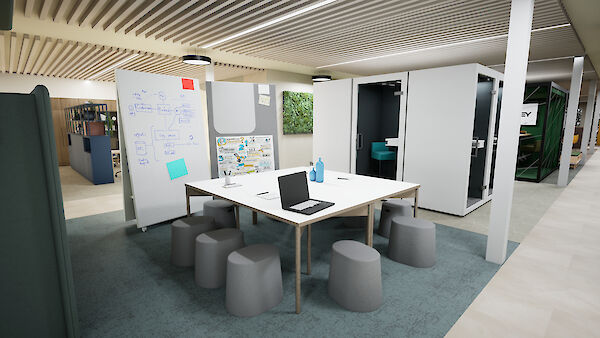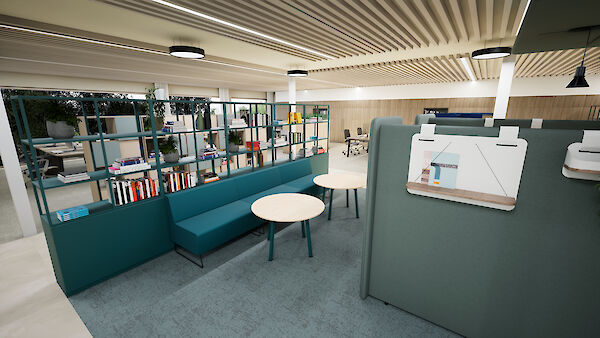
Hybrid-working is becoming the new normal. There’s lots to be said for working remotely – it can make us agile, solving time and distance problems, and can help focus, too – but, in some cases, face to face collaboration will always win. Businesses are recognising that they need a mix of the two to get the most out of their colleagues.
Our Creative Director, Jeanine Goddard, shares her thoughts on different types of collaboration that work best face to face, and how you can go about setting up your workplace effectively from a design and space planning perspective.

When face to face collaboration is best
Remote working can be great for focus, and for really ‘head down’ tasks. But anything where you need the collaborative, creative input of other people is much easier to achieve face to face – where you can benefit from shared ideas and spontaneous conversation.
But it’s not as simple as just getting in a room together. To really maximise face to face collaboration, you’ll need to zone your space to create a range of varied areas that are really fit for purpose.
Working out what type of collaboration space you need
There are so many ways to collaborate, and proper meeting or collaboration settings can vary hugely. In some cases, a space for confidential conversation between two people is the best way to use an area, and, in others, it’s setting up a room to accommodate 30 people to share ideas dynamically.
There are several core elements that will determine which set up you need for your collaboration. Ask yourself: how long will it last? How many people are involved? What is the purpose? What technology or tools will be required?
Once you’ve answered those questions, you’ll be in the right mindset to start designing your space appropriately.

Designing your collaboration space
The set up that you’ll need really depends on what sort of communication and collaboration you’re planning on having.
Offering different working postures is really important in collaboration, as you’re giving people an opportunity to choose where they feel comfortable. So, having a mix of normal seating height, but also some standing height or bar stool settings can work well.
If you’ve got a large group, and you’re keen for everyone to participate, make sure there’s not room for people to ‘hide’ at the back. Elevate the back seats, or make sure everyone sits round in a semi-circle, the same distance from the speaker or facilitator, so that you can make sure everyone feels included, and that it’s easy for them to contribute.
If you’re expecting creativity, give people plenty of tools to be creative – with lots of wall space, white boards or poster paper, and things to get people scribbling and sharing. Remember, for collaboration to work effectively, your space needs to be set up correctly for the number of people participating – make sure that everyone has the same tools, so that they’re ready to be engaged.
When designing your collaboration space, the most important thing to remember is that flexibility is key. Give yourself room to adapt your space – think about using tables and chairs that are on casters so you can move them around quickly, having optional dividing walls, or utilising stacking or flexible furniture.
People are different and collaboration takes many forms. By building flexibility into your space, you’ll be setting yourself up to make the most out of your face-to-face collaboration sessions.